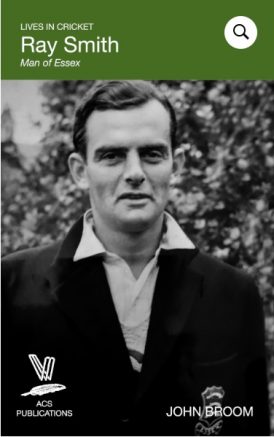Ray Smith: Man of Essex
Martin Chandler |Published: 2022
Pages: 237
Author: Broom, John
Publisher: ACS
Rating: 3.5 stars

Cricketing biographies, especially of English players, are one of the staples of sports publishing and quite a few men with long careers in the game but no international honours to show for it have been subjects in recent years. To that list can now be added the name of Ray Smith, who made his debut for Essex in 1934 at the age of 19, and retired 22 years later at the close of the 1956 season.
It took Smith a while to establish himself in the Essex side, and he was very much a man for whom the six seasons lost to the Second World War would have seen him, if not at his peak, then well on the way to it. By the time peace and full time cricket returned others, most notably his county teammate Trevor Bailey, were destined to fill the all-rounder’s slot in the England team.
Like Bailey Smith was a right arm seam bowler, not of express pace but certainly sharp and with a great deal of stamina. Unlike Bailey however he also had a second string to his bowling bow, as he was also a decent off spinner. As a batsman, also unlike Bailey, Smith was an aggressive crowd pleaser and those talents, along with his athleticism in the field, mean that he would have been a man well suited to the shorter formats of today.
The crucial question of course is, whatever his achievements in county cricket, does Smith’s life story make for good reading? There are promising signs, not least of those being the man who chose to task himself with the job. John Broom has been researching Smith for some time and, in recently publishing excellent books on cricket during the Great War and Second World War, he has proved himself to be a thorough historian and a writer with an interesting and engaging style.
In the circumstances it is hardly surprising that a detailed picture of Smith’s career emerges from the book. There is the ever-present danger in taking a linear path through a cricketer’s life that a reader can get bored of reading what amounts to little more than a series of quotes from contemporary press reports. No one who has read Broom’s previous books will be surprised to learn that that is a trap he comfortably avoids. The matches he chooses to describe always have something of interest in them (most particularly to this Lancastrian a couple of stunning Essex victories over Yorkshire) and he never loses sight of the need to put Smith’s career in the wider context of his life and times.
To give an example the account of the 1948 season looks at some of Smith’s on field contributions, most notably the innings which, fourteen years on from his debut, was the first of what was to become a total of eight First Class centuries. Rather more words however are given to a match in which neither Smith nor any of his teammates achieved much in the way of personal glory, the famous match against Bradman’s ‘Invincibles’ when 721 runs were conceded to the Australians on the first day.
Away from the cricket itself 1948 saw Smith secure a winter’s coaching work in South Africa, the retirement in not entirely straightforward circumstances of his cousin, leg spinner Peter and, keeping the thorny question of remuneration firmly in focus, a lengthy look at the events surrounding Trevor Bailey’s appointment as Essex’s Assistant Secretary.
Much of the book is of course concerned with the county championship, but there are interesting digressions involving Smith’s extensive involvement in wartime cricket. One of the more remarkable snippets that Broom’s reader learns is that whilst Smith could, presumably, have avoided military service on the basis of having a reserved occupation via his farming background he nonetheless chose to try and join up. The professional sportsman was not however acceptable to the Army (due to flat feet), nor the Navy (because of his inability to swim)!
His lack of Test recognition notwithstanding Smith did take part in one overseas tour, with a powerful Commonwealth XI led by ‘Jock’ Livingston that toured the sub-continent for five months in 1949/50. The chapter dealing with that trip is certainly one of the book’s highlights.
As indicated Smith’s family were involved in agriculture, and in later life he moved into coaching so, in many ways his was not a remarkable life. But his life story is raised well above the mundane by the co-operation that Broom has received from the two sons of Smith’s second marriage, and by the memories of Geoff Smith (no relation) and Barry Knight who played with Smith, as well as John Wild and MJK Smith who played against him. The result is a fully rounded life of a stalwart county cricketer who, during his time, brought great pleasure to many, not least amongst them it seems John Broom’s father – from tiny acorns and all that!






Leave a comment